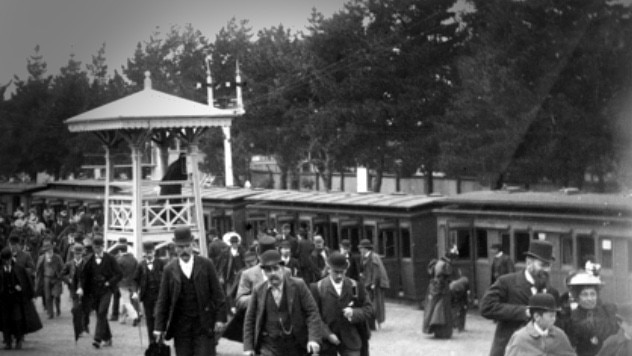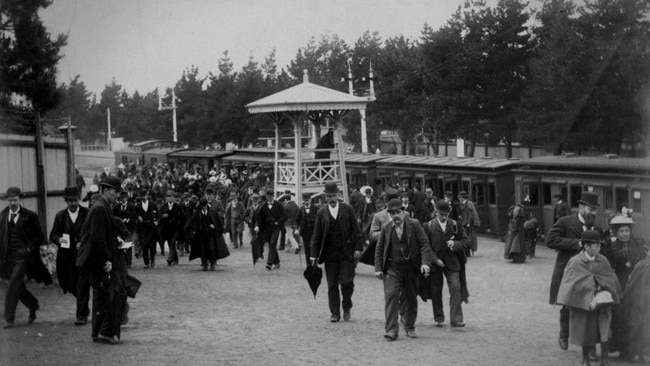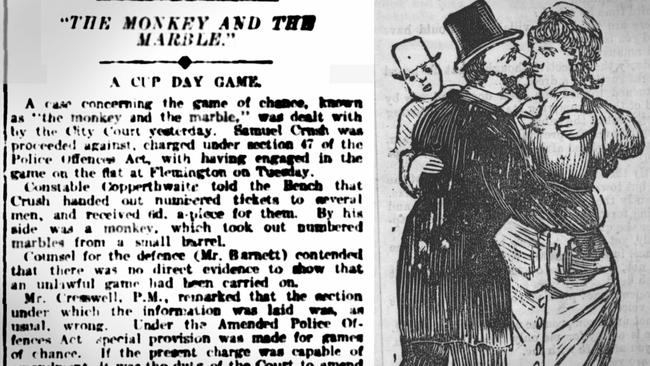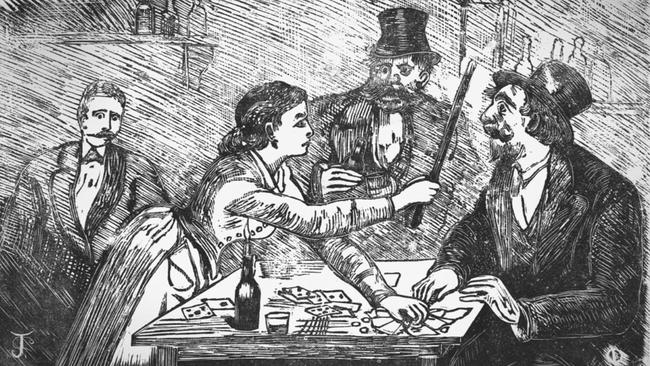How Melbourne Cup race goers were conned out of their money in the 1880s
The famous race has attracted some outrageous swindlers over the years, including a man who brought his monkey to Flemington.

Victoria
Don't miss out on the headlines from Victoria. Followed categories will be added to My News.
If you think your Flemington bookie is a thief in a tailored suit, spare a thought for the patrons of the Melbourne Cup in the 1880s.
In a time when cashed-up wool workers poured into Melbourne for a punt at the spring races, a silent army of pickpockets, swindlers and card sharps was waiting at the track to relieve them of their money.
The outrageous tricks employed by the industrious con artists were complex enough for many of the career crims to escape with their freedom.

The disappearing act
Before the race goers even got to Flemington, their money was in the sights of pickpockets and thieves.
With the wool trade booming, country labourers would arrive in Melbourne with wallets literally bulging with cash, ready to splash at Flemington.
One account describes such a racegoer distracted by a gleaming jewel in a Melbourne shop window before a stranger stumbled into him, knocking the victim in the chest.

The pickpocket was not the sort of street rabble one might expect.
He was a well-dressed and clean-cut figure who mumbled his apology and disappeared as soon as he came.
The victim’s wallet had disappeared too; something he only noticed minutes later.
During the spring racing season in 1888 the Herald newspaper warned Melburnians that even the wiliest conmen and card sharps resting from their usual dark arts could not resist the sight of the bulging breast pocket of a country buck freshly alighted at a Melbourne railway station for the races.
The monkey and the marbles
A scam known as the Monkey and the Marbles was a standout favourite among Cup Day tricksters.
A scammer would appear near the entrance of Flemington or among the crowd, with a small wooden barrel full of marbles and a monkey on a chain.
The scammer offered eager punters a lottery-style game where they could buy a ticket for a half sovereign.

The monkey would draw a numbered marble from the barrel (hence the operator could not be accused of cheating) and the holder of the corresponding ticket would win the pool of half sovereigns.
The scammer promised he would only take a small percentage of each pool for his trouble.
Little did the gamblers know, two or three members of the crowd were in cahoots with the operator.
He would keep track of the ticket numbers they held, and when the monkey presented him with a marble, he would call out his mates’ numbers regardless of the marble’s true number.

Now and then the scammers would allow a member of the public to win, usually a young woman, to encourage more punters with to take part as the entry amount increased.
A core of stayers, usually young men from the country unaccustomed to the perils of the city, would chase their money in the monkey’s barrel until they were bled dry.
The game would pull in more than a hundred pounds per day – thousands in today’s money – for each racing day it operated.
Despite countless gamblers getting fleeced by the monkey, police were sometimes powerless to prosecute the scammers.
The con continued well into the 20th Century.
In one 1909 case a scammer named Samuel Crush was brought before a Melbourne judge, accused of peddling the monkey scam at Flemington on Cup Day.
While plenty of witnesses saw him running the monkey game, the evidence could not prove beyond reasonable doubt that anything illegal had happened, so the judge reluctantly set him free.
Card sharps and conmen
As punters hungry for a quick buck poured into Melbourne for the races, card sharps were on the prowl.
A popular scam was to lure a group of men into a game with three cards, one of which was a Queen.
Once the cards were shuffled, the gamblers were invited to place bets on which card was the Queen.

The scammer would place a small spot of paper or tissue on the back of the Queen card in such a way that the gamblers would notice it.
But the scammer himself would pretend not to see it.
This would lure the punters into believing they could easily identify the Queen and they would load up bets on the card with the mark.
But using sleight of hand the swindler would transfer the mark to another card during the shuffle, fleecing the gamblers.
Another less effective scam involved a man posing as a purse salesman who convinced potential customers he had made a wager that he would sell his full load of Russian wallets before the end of the racing season.
He was so desperate to sell, he put two sovereign coins in the wallet before the customer’s very eyes, then offered to sell it, jingling coins and all, for just a half sovereign.
Not believing their luck, the customer would fall for the trick, and the salesman would be gone before the victim realised the poor-quality wallet contained only tuppence, switched with sleight of hand.
But the audacious scams couldn’t last forever, and neither could the boom times of the 1880s.
The devastating financial crash of the early 1890s made sure there were far fewer fat wallets on show at the Melbourne Cup.
More Coverage
Originally published as How Melbourne Cup race goers were conned out of their money in the 1880s




